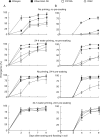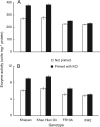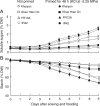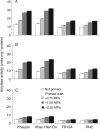Seed pre-treatment in rice reduces damage, enhances carbohydrate mobilization and improves emergence and seedling establishment under flooded conditions
- PMID: 22476478
- PMCID: PMC3072768
- DOI: 10.1093/aobpla/plr007
Seed pre-treatment in rice reduces damage, enhances carbohydrate mobilization and improves emergence and seedling establishment under flooded conditions
Abstract
Background and aims: Early flooding helps control weeds but reduces seedling establishment in direct-seeded rice (Oryza sativa). When combined with appropriate management practices, the use of genotypes that better tolerate flooding during emergence can enhance crop establishment in flood-prone areas. Management options include seed pre-treatment and we tested the influence of pre-soaking for 24 h prior to sowing or of priming (soaking for 24 or 48 h followed by drying).
Methodology: The effects on seedling establishment after 21-day flooding of pre-soaking seeds for 24 h before sowing and/or of priming seeds were examined together with physiological responses connected with reactive oxygen scavenging. Seeds of four lines with contrasting abilities to tolerate flooding at the germination stage were compared. Seeds were primed using KCl solutions (48 h) or water (24 h) and pre-soaked using water. Lipid peroxidation and activities of reactive oxygen-scavenging enzymes were measured in seeds before sowing. Carbohydrate mobilization in germinating seeds and seedling growth were also monitored at intervals.
Principal results: Seed pre-treatment by pre-soaking or by priming increased survival of flooding and accelerated and improved seedling establishment, especially in tolerant genotypes. Primed seeds had less lipid peroxidation and higher superoxide dismutase (SOD) and catalase (CAT) activities than non-primed seeds. Amylase activities and starch breakdown were also hastened in primed seeds. Survival after flooding was positively correlated with amylase activity but negatively correlated with the extent of lipid peroxidation.
Conclusions: Pre-soaking and priming improved seedling establishment in flooded soil, enhanced the capacity to scavenge reactive oxygen species in seeds by increasing SOD and CAT activities, and hastened carbohydrate mobilization. Tolerant genotypes responded better to these treatments, emphasizing the effectiveness of combining genetic tolerance with appropriate seed pre-treatment to improve seedling establishment of rice sown in flooded soils.
Figures








Similar articles
-
Responses of AG1 and AG2 QTL introgression lines and seed pre-treatment on growth and physiological processes during anaerobic germination of rice under flooding.Sci Rep. 2020 Jun 23;10(1):10214. doi: 10.1038/s41598-020-67240-x. Sci Rep. 2020. PMID: 32576897 Free PMC article.
-
Mechanisms associated with tolerance to flooding during germination and early seedling growth in rice (Oryza sativa).Ann Bot. 2009 Jan;103(2):197-209. doi: 10.1093/aob/mcn211. Epub 2008 Nov 10. Ann Bot. 2009. PMID: 19001425 Free PMC article.
-
Adaptation to flooding during emergence and seedling growth in rice and weeds, and implications for crop establishment.AoB Plants. 2012;2012:pls019. doi: 10.1093/aobpla/pls019. Epub 2012 Sep 5. AoB Plants. 2012. PMID: 22957137 Free PMC article.
-
Seed priming to alleviate salinity stress in germinating seeds.J Plant Physiol. 2016 Mar 15;192:38-46. doi: 10.1016/j.jplph.2015.12.011. Epub 2016 Jan 16. J Plant Physiol. 2016. PMID: 26812088 Review.
-
Flooding Tolerance of Rice: Regulatory Pathways and Adaptive Mechanisms.Plants (Basel). 2024 Apr 23;13(9):1178. doi: 10.3390/plants13091178. Plants (Basel). 2024. PMID: 38732393 Free PMC article. Review.
Cited by
-
Deciphering Genetics Underlying Stable Anaerobic Germination in Rice: Phenotyping, QTL Identification, and Interaction Analysis.Rice (N Y). 2019 Jul 15;12(1):50. doi: 10.1186/s12284-019-0305-y. Rice (N Y). 2019. PMID: 31309351 Free PMC article.
-
Unraveling the genetic potential of native rice (Oryza sativa L.) landraces for tolerance to early-stage submergence.Front Plant Sci. 2023 May 18;14:1083177. doi: 10.3389/fpls.2023.1083177. eCollection 2023. Front Plant Sci. 2023. PMID: 37275250 Free PMC article.
-
Herbal and chemical seed potentiations improve the redox health of aged seeds of indigenous aromatic rice cultivars through regulation of oxidative window, gene expression, and restoration of hormonal homeostasis.Physiol Mol Biol Plants. 2023 Sep;29(9):1269-1288. doi: 10.1007/s12298-023-01375-9. Epub 2023 Oct 28. Physiol Mol Biol Plants. 2023. PMID: 38024956 Free PMC article.
-
Early seedling vigour, an imperative trait for direct-seeded rice: an overview on physio-morphological parameters and molecular markers.Planta. 2015 May;241(5):1027-50. doi: 10.1007/s00425-015-2273-9. Epub 2015 Mar 25. Planta. 2015. PMID: 25805338 Review.
-
Drought resistance in rice seedlings conferred by seed priming : role of the anti-oxidant defense mechanisms.Protoplasma. 2013 Oct;250(5):1115-29. doi: 10.1007/s00709-013-0487-x. Epub 2013 Feb 27. Protoplasma. 2013. PMID: 23443969
References
-
- Angaji SA, Septiningsih EM, Mackill DJ, Ismail AM. Identification of QTLs associated with tolerance of anaerobic conditions during germination in rice (Oryza sativa L.) Euphytica. 2010;172:159–168. doi:10.1007/s10681-009-0014-5. - DOI
-
- Asada K, Urano M, Takahashi M. Subcellular location of superoxide dismutase in spinach leaves and preparation and properties of crystalline spinach superoxide dismutase gene sodA. European Journal of Biochemistry. 1973;36:257–266. doi:10.1111/j.1432-1033.1973.tb02908.x. - DOI - PubMed
-
- Balasubramanian V, Hill JE. Direct seeding of rice in Asia: emerging issues and strategic research needs for the 21st century. In: Pandey S, Mortimer M, Wade L, Tuong TP, Lopez K, Hardy B, editors. Direct seeding: research strategies and opportunities. Los Baños, Philippines: International Rice Research Institute; 2002. pp. 15–39.
-
- Basra SMA, Zia MN, Mehmood T, Afzal I, Khaliq A. Comparison of different invigoration techniques in wheat (Triticum aestivum L.) seeds. Pakistan Journal of Arid Agriculture. 2002;5:11–16.
-
- Beers RF, Sizer I. A spectrophotometric method for measuring the breakdown of hydrogen peroxide by catalase. Journal of Biological Chemistry. 1952;195:133–140. - PubMed
LinkOut - more resources
Full Text Sources
Other Literature Sources
Miscellaneous

